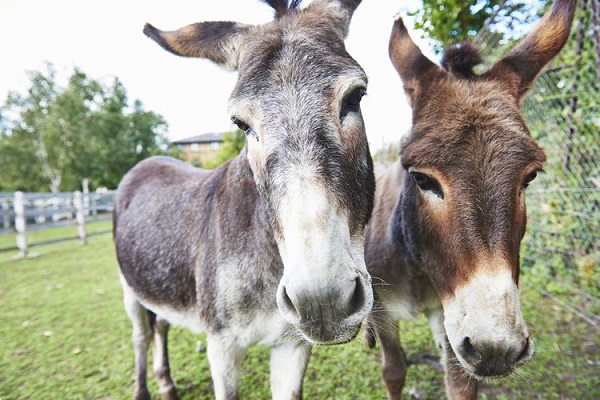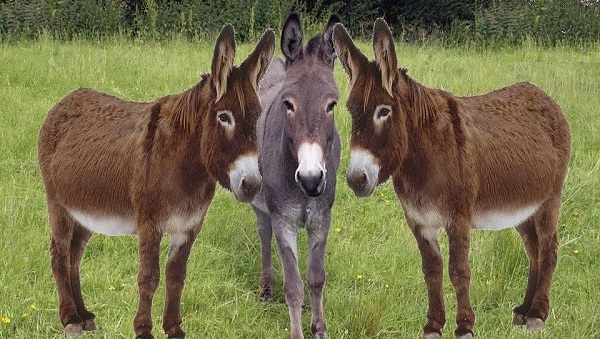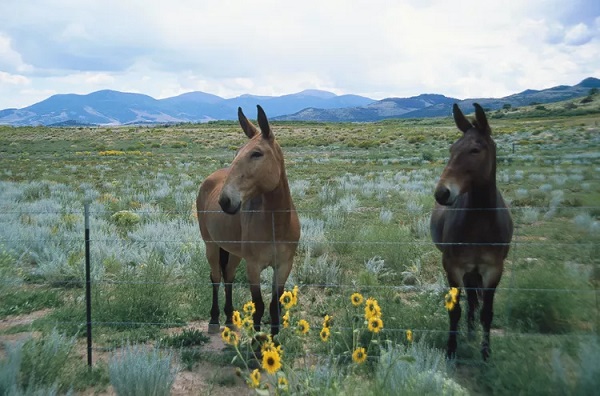
Donkeys and mules look a lot alike with their telltale long ears, broad heads, thin limbs, and short manes. Being the offspring of a male donkey (jack) and a female horse (mare), it’s safe to say many of a mule’s traits hail from the paternal side of its lineage. However, mules typically take after their mothers in body shape, size, and coat. They’re more likely to be mistaken for horses than for donkeys.
Besides their physical characteristics, there are many differences between these two domestic equids—one is sterile, for example, and therefore technically not even considered a species. Learn more about mules and donkeys, including how to tell the two apart, the next time you encounter one of these commonly confused animals.
Key Differences
- Size: Mules are bigger than donkeys, standing about 60 inches at the withers versus 45 inches.
- Body shape: Mules have a slight curve in their backs, similar to horses, whereas donkeys’ backs are flat.
- Markings: Donkeys have a primitive marking known as a dorsal line, shaped like a cross, stretching down their backs and across their shoulders, and mules don’t.
- Ears: Both have long ears, but donkeys’ ears are dark at the tips and around the edges.
Their Classification

The donkey (Equus asinus) belongs to the family Equidae and genus Equus, along with horses and zebras. It’s classed as such because it has a long neck, a mane, and a single toe on each foot. Donkeys differ from their horse relatives in face shape (a donkey’s is much shorter), ear structure (which is longer and thicker), and back composition (flatter than a horse’s and containing one fewer vertebrae).
Mules are bred from male donkeys (Equus asinus) and female horses (Equus caballus)—a female donkey breeds with a male horse and produces a hinny. Hinnies are not as common.
YOU MAY ALSO LIKE: Top 10 Surprising Facts About Donkeys
Mixing the chromosomes of horses and mules causes both mules and hinnies to be sterile, except on a few recorded occasions. And because “species” is technically defined as “a group of living organisms consisting of similar individuals capable of exchanging genes or interbreeding,” mules and hinnies are not considered species. They’re hybrids, rather. They do, however, have a scientific name, Equus mulus.
Mules, of course, belong to the same family and genus as donkeys and horses.
Characteristics of Donkeys vs. Mules
Donkeys and mules are tough to tell apart by looking at them, but they do have some distinguishing physical features, one of the most prominent being a primitive marking belonging to only one.
Head
Mules and donkeys are known to have short, thick heads, but the donkey’s head is slightly shorter and thicker than the mule’s. Compared to a horse, a mule has long ears. But the mule’s ears resemble the shape of the horse’s ears, whereas a donkey’s ears are thicker and more widely set. The openings are larger and adapted for temperature regulation, a helpful trait in the hot desert where donkeys originated. Another subtle difference: Donkeys’ ears, unlike mules’ ears, darken at the tips and around the edges.
Body Size and Shape

Donkeys have flat backs and mules have slightly curved backs, like a horse’s, but less exaggerated. Mules are bigger than donkeys, taking their size after horses. Mules and horses both reach about 60 inches—or 15 hands—from hoof to withers (shoulders), whereas donkeys stand only about 45 inches at the withers.
Donkeys and mules both have thin limbs and narrow hooves.
Coat
Mules have short manes like donkeys, not like horses. A mule’s coat, however, is more like a horse’s, meaning it has relatively fine hair that comes in various colours—including brown, reddish-brown (“bay”), black, grey, or even white, palomino, and dun.
Donkeys have coarser coats and are usually grey, although some are black or brown. They have a distinguishing dorsal line, a primitive and crosslike marking that begins at the base of the mane, trails down the spine, and typically intersects with a stripe that connects the shoulders.
Conservation Status
Most donkeys and mules are domestic. In the United States, they exist only in zoos and pastoral environments, except for a few domestic burro populations that have returned to the wild across the West and Southwest. Outside of the U.S., the equids also occur across Mexico, Central and South America, Asia, and Africa. Donkeys and mules are some of the most common working animals in the world, used for tourism, transportation, and agriculture.
The African wild ass, a subspecies and suspected descendent of the donkey, still roams free but is rapidly disappearing across its native Horn of Africa range. The IUCN has listed it as critically endangered since 1996. There are believed to be only 23 to 200 mature individuals left.
Hunting—for food and medicinal purposes—is the biggest threat to the African wild ass according to the IUCN. African locals source their bones and body parts to treat many maladies, from backaches to tuberculosis. Potential interbreeding with the domestic donkey is another threat, though there is no evidence that this is a common problem.



